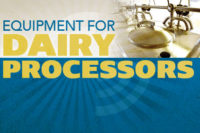CCL Label debuts new packaging technology

CCL Label launched a new version of its EcoFloat low-density polyolefin sleeve material: EcoFloat WHITE.
“EcoFloat WHITE will enable larger recyclability for dairy packaging. We expect it to be a gamechanger. The dairy industry often utilizes HDPE bottles for bottles that contain yogurt and probiotic drinks or similar products. But these white HDPE bottles are rarely recycled back into food grade applications for several reasons like strict food contact regulations – so the bottles leave the packaging loop”, stated Guenther Birkner, member of the management team at CCL. “We have seen a large trend to move out of HDPE towards PET which works well in terms of recycled content for food packaging and we are looking to support this with a functional product decoration”.
One vital necessity for dairy products is are light blocking properties to keep the product fresh and to maximize shelf life. In the past this light blocking barrier has often been achieved with a layer of black or silver ink, that protected the products but could also be detrimental to sorting and recycling because the standard near infrared detection system commonly used could have difficulties detecting the underlying material, CCL Label stated.
“As 80 percent of recycling actually is sorting, we needed to make sure that our solution was detectable by standard technology that is used today in the recycling industry,” said Norbert Fenkart, who heads up the research and development (R&D) department in CCL’s sustainable sleeve label hub Dornbirn in Austria. “We use carbon-free inks to create additional light blocking properties on the sleeve. These work well in NIR detection* and the underlying rigid PET bottle is detected and the bottle is sorted into the right waste stream.”
The sleeve also supports when it comes to the crucial sink/float process step in PET recycling because it is made of a low- density polyolefin material that floats. It detaches automatically from the PET bottle flakes and the density separation is very easy and clean: the heavier PET flakes sink to the bottom of the vessel while the floatable material gathers at the top of the vessel and can be easily captured and removed.Looking for a reprint of this article?
From high-res PDFs to custom plaques, order your copy today!







